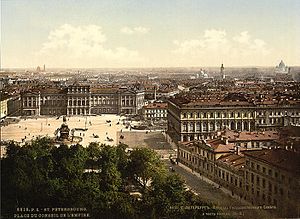| Revision as of 22:52, 6 October 2006 editFisss (talk | contribs)2,324 editsNo edit summary← Previous edit | Revision as of 22:52, 6 October 2006 edit undoFisss (talk | contribs)2,324 editsNo edit summaryNext edit → | ||
| Line 1: | Line 1: | ||
| ] | ] | ||
| '''St Isaac's Square''' is a ] located next to the ] in ], ]. It can be described as a monumental structural building that has an eight-column portico that faces Admirality. In ]-], Auguste Montferrand designed the structure for Prince ] ]. In the main porch lies two ] of ] on ] pedestals that are mentioned by the great Pushkin in his poem ''The Bronze Horseman''. | '''St Isaac's Square''' is a ] located next to the ] in ], ]. It can be described as a monumental structural building that has an eight-column portico that faces Admirality. In ]-], Auguste Montferrand designed the structure for Prince ] ]. In the main porch lies two ] of ] on ] pedestals that are mentioned by the great Pushkin in his poem ''The Bronze Horseman''. | ||
| ⚫ | ] | ||
| ⚫ | ==Inside Structure== | ||
| ⚫ | ==Inside Structure== | ||
| ⚫ | ] | ||
| The center of St. Isaac's Square lies the ] to ]. Opposite of the ], on the bank of ] stands a former palace built in 1829-1844 for ], who was the daughter of Nicholas I (architect Andrei Stakenschneider). Currently the former ] serves as the seat of the St.Petersburg Council of city's Deputies. | The center of St. Isaac's Square lies the ] to ]. Opposite of the ], on the bank of ] stands a former palace built in 1829-1844 for ], who was the daughter of Nicholas I (architect Andrei Stakenschneider). Currently the former ] serves as the seat of the St.Petersburg Council of city's Deputies. | ||
Revision as of 22:52, 6 October 2006

St Isaac's Square is a city square located next to the St Isaac's Cathedral in St. Petersburg, Russia. It can be described as a monumental structural building that has an eight-column portico that faces Admirality. In 1817-1820, Auguste Montferrand designed the structure for Prince Lobanov Rostovsky. In the main porch lies two statues of lions on granite pedestals that are mentioned by the great Pushkin in his poem The Bronze Horseman.
Inside Structure

The center of St. Isaac's Square lies the monument to Tsar Nicholas I of Russia. Opposite of the cathedral, on the bank of Moika stands a former palace built in 1829-1844 for Princess Maria, who was the daughter of Nicholas I (architect Andrei Stakenschneider). Currently the former Mariinsky Palace serves as the seat of the St.Petersburg Council of city's Deputies.
City Council
The City Council copes with the problems of the city, which stands at five million.. The 600 deputies under the 20 comissions , which consist of planning and budget, culture, health care, youth affairs, and environment preservation commisions and etcera. The most contraversial issues are dealt and discussed at City Council.
The Blue Bridge, which is the widest in St Petersburg (aprox 100m), allows one to travel to Saint Isaac's Square. TheBlue bridge connects two banks at Moika, which makes it a possible extension to the place. Next, on the right-hand side stands Neptune's Scale, which is aso made of granite at the top. On the stele, water levels during deep floods are marked with copper strips. The notorious hotel of Hotel AStonia, among other hotels border St. Issac's Square. It was made by architect Fyodor Lidval in 1911-1912, and proved to be one of Russia's best.
Other parts
Houses 13 and 14, which overlook Moika are accompanied by the Russian Institute of Plant Breeding which presents the name of Academician Nikolai Vavilov, a prominent Russian scientist. The institute shared a unique collection of 160,000 cultivated plants, which Nikalao Vavilao collected while travelling in every continent from 1921 to 1940. After the end of the war, the London magazine wrote that his collection was lost-simply destroyed in the siege. However, it was false; many starved to death, the institute's staff would not involve itself single grain of rice or potato tuber.
The building found at the corner Bolshaya Morskaya Street is famous for writer Fyodor Dostoyevsky, who lived there from 1848-1849. At his timely stint there, he published White Nights. Among this are many other St. Petersburg embarkments.
Trivia
- St. Isaac's Square that was sculpted by Pyotr Klodt has only two points of support.